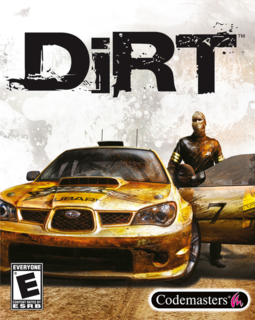...:::DiRT:::...
Since I reminded you of the replay system, I allow myself to ascertain that it bashfully gains upon the model inaugurated more than seven years ago, by RC 2000. A notice for film addicts and video editing passionates: launch the Fraps application and use the "abilities" of switching the camera, rewind, and slow down the play rate, in order to assemble your own advertising trailer. For whatever reason you find it fit. Hmm, I'm starting to wander way off right now. Let's come back to our beloved black sheep. Pardon me, our piebald ones, since I'm about to debate the graphical presentation, which raised enough controversies to date. But not before I announce with dolor in my "voice", that the multiplayer support is a major flout (the praises are reserved for the netcode). Two game modes (Rally and Hillclimb), a smallish tiered lobby laden with up to a hundred players (and their statistics) voting for the next stage, and the lack of some elementary options, such as car choice and a search engine for specific rooms. And if you come to thing that I wanted to have my car tuned up prior every race! Getting back to graphics, there are many things to be said, and that's precisely why I'll try to stick to the essential. Leave aside the "official" screenshots. Or, if you get lucky (like myself) and start with the proper races, we can take into consideration, for about ten minutes, the fact that DiRT shows itself similar to a pre-rendered movie from the yesterday games. I'm not deceiving you. At times, both cars and especially the tracks look sensational. From the dirt which adders to the bodywork, and the few examples of an interactive environment (destructible objects planted along the track, dashed rubber bales, bulwarks bended under pressure, shrubs flattened by bumpers), to everything what an exemplary car damage model means (impressive as always, throughout the series). Then, a bunch of incriminating images for the excessive use of visual artifices slowly creeps in. And that's a shame. I count the small number of polygons in close-up surface renderings, the eye-bleeding HDR lighting, and the disappointingly dull particle system when used to simulate the trails of dust. Alas, even the lesser of things cost. Too much, in my opinion, and in this case, the stolidity reaches an unsuspectedly high "bench mark". The frame-rate is a constant nuisance, fluctuating and taking serious drops whenever the accuracy imports the most. Even top of the line systems are at pains, if one tries, as it would be normal, to crank the details all the way up (ultra, in the current case). A single official assertion, presented in the newly launched patch's read-me, is worth a thousand other words: "Ultra graphic settings modified slightly to be usable with hardware of today". I rest my case! As a sound representation, DiRT does, at times, bizarre things, to say the least and to replace the "off-color" word. No, it's not the absence of Grist's voice that bothered me, but the lines worthy of the cheapest of B movies, tied in the beginning of each stage, randomly mixed, and galling through the untiring rehearsal of awkwardness. Other than that, there's nothing to indict. By changing the view, the sound modifies its values, with emphasis on different progressive effects, while the explanatory narration fell on the shoulders of Travis Pastrana (a renowned champion and gold medal winner in the X Games competitions). By admitting the staggering four-wheel battle on the console tracks, all this production effort seems to be justified. But that fails to comfort the earliest upholders of a franchise that, as far as I'm concerned, has started to walk on two lines from the moment the third installment has seen the publishing light. One thing is more certain that the rest. The Colin McRae Rally series is dead. Officially buried, and with all the proper bells and whistles involved.

